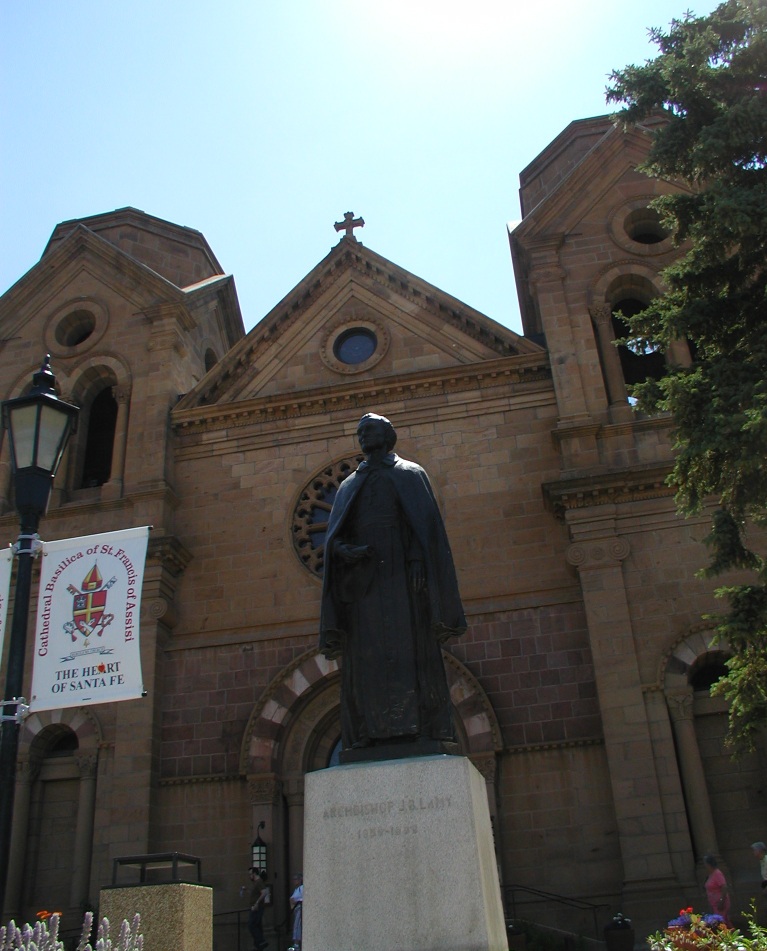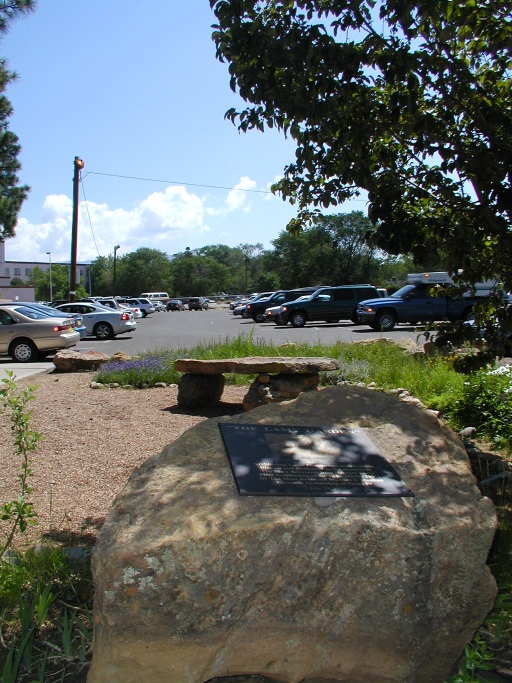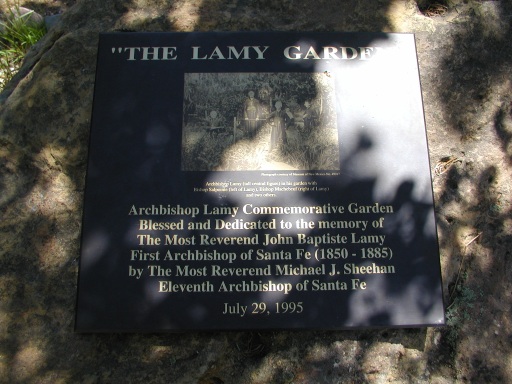
copyright 2006 by George Johnson

photo by George Johnson, copyright 2006
1. Retrofit Arithmetic (and Rainbarrel Economics)
July 7, 2006
24. Archbishop Lamy's Parking Lot
"The garden was walled with adobes by his first French architects, who had crafted its main entrance out of native granite. There was a sparkling fountain, and a sundial stood on a pedestal of polished Santa Fe marble. Aisles of trees, plants, and arbors led to it from all quarters of the enclosure. Formal walks reached from one end of the garden to the other, with little bypaths turning aside among the flower beds and leading to benches cunningly placed in the shade . . .
"At the south end of the garden on its highest ground was a spring which fed a pond covering half an acre. From the pond flowed little graded waterways to all parts of the garden. In the pond were two small islands on one of which stood a miniature chalet with a thatched roof. Little bridges led to the islands. Flowers edged the shores, and water lilies floated on the still surface, and trout lived in the pond and came to take crumbs which the archbishop threw to them. Now and then he would send a mess of trout over to St Michael's College to be cooked for the scholars. . . .
"Sweeping the long shady vista and its bright colors of fruit and flower with a gesture, he would say that the purpose of it all was to demonstrate what could be done to bring the graces and comforts of the earth to a land largely barren, rocky, and dry." -- Paul Horgan, Lamy of Santa Fe
There is not much left of Archbishop Lamy's garden, just a few lilacs and an unkempt patch of gravel and wildflowers that was recreated as an afterthought, more than a century after his death. A bit of lavender and nepeta, some lilies and marguerite daisies, a single cherry tree -- all waging a struggle against dandelions, cheat grass, and sprouting Siberian elms.
Standing at the edge and looking east across the asphalt, one can imagine how it used to be: five acres of orchards and vineyards extending all the way to the Alameda. There were "Malaga grapes whose bunches finally measured fifteen inches long . . . red and white currants, plums as large as hen's eggs." There were stately (presumably not Siberian) elm trees, maples, cottonwoods, locusts, and weeping willows -- almost all of it now paved over and leased to the city for a parking lot.
A recent
piece in the Journal by Karen Peterson described the final chapter in this sad tale. Scouring the newspaper archives she found a letter to the editor, apologetic in tone, written in January 1984 by two well known local developers, Al Grubesic and C. L. "Lee" Brown. Mr. Grubesic is the father of state senator John Grubesic and Mr. Brown is currently a partner with former mayoral candidate David Schutz in a plan to build a subdivision called Santa Fe Canyon Ranch near the village of La Cienega.
After negotiating with the church, the two men had struck a deal to lease about three acres of the old garden for a real estate development -- "retail establishments, professional offices, condominiums and apartments," much like what the Archdiocese is planning today. Eager to get started, they brought in some heavy machinery and, without a permit, scraped it flat, "clearing the area of debris."
As they tell the story, the garden had already been allowed to deteriorate and was now a hangout for derelicts and "poachers in recreational vehicles and mobile homes who seemed to have taken up residence." These were the days of double-digit interest rates (remember stagflation?), and financing for their project fell through. With no more need for the land, they covered it with blacktop.
The bigger issue is why the church let Lamy's garden fall into such a sorry state, and here the details are a little vague. Marc Simmons, in one of his columns on New Mexico history, quoted a Santa Fe woman who remembered that, as late as 1915, a duck pond still existed. She speculated that a new dam built in upper Santa Fe Canyon in the late 1920's (that would have been the Granite Point Dam, later replaced by McClure Reservoir) lowered the water table and dried up the spring that fed the gardens.
Whatever the cause, they were gradually allowed to wither. By the late 1960s, the garden had become "a trash heap," as Monsignor Jerome Martinez y Alire described it in last Sunday's New Mexican. "It had to be cleaned up." But that only begs the question. Was the only alternative to bury it with asphalt?
By scaling back its plans to heap a three-story development on the ruined land, the Archdiocese has regained some moral high ground. It has also opened up a heroic possibility. With all the philanthropic money available in Santa Fe, surely enough could be raised to save just one acre from the bulldozers and, perhaps with the help of the Santa Fe Botanical Garden, bring a large piece of Lamy's sanctuary back to life. Maybe Mr. Brown and Mr. Grubesic would be willing to lend a hand.
The result would be an island within whatever else the church has planned -- not another of the perfunctory xeriscapes one sees outside every office building, but something grander.
Irrigation would come from the runoff shed by the roofs of the development. In drier times maybe the Acequia Madre association could be persuaded to loan some of its water. Who knows, if the city ever sees fit to keep a little water in the river, Lamy's old spring might even come seeping back.
Bringing back the Archbishop's garden would be a gift to all of Santa Fe, a way for the church of Anselm, Augustine, Boethuis, and Aquinas to show that life is about more than money, that land and water are not just commodities to be bought and sold.
Coming Soon: The Battle for Talaya Hill
The Andrew and Sydney Davis Webcam
The Santa Fe Review
More links:
See the current flow of the Santa Fe River above McClure Reservoir
with
the USGS automated gauge.
The Otowi
gauge shows the flow of the Rio Grande north of Santa Fe.
Santa Fe water information, a collection of documents and links
(counter activated 2/20/04)
2. The San Juan-Chama Shell Game
3. The Case of the Disappearing Aquifer
4. The Creative Hydrology of Suerte del Sur
5. The City, the County, and a Water Tax Revolt
6. Water Numerology at City Hall
(Our story thus far)
7. The Woman at Otowi Gauge
8. "Forget it, Jake. It's Chinatown."
9. The Las Campanas Connection . . . desalination word games . . . and Aamodt South
(Our story continues)
10. The Engineering Solution
11. The Sorrows of San Acacio
12. The City's Dubious Water Report
13. Where the Water Went
14. Shutting Down the River Again
15. Picking on the Davises
16. The Tom Ford Webcam
17. Galen Buller's Day Off
18. Forgive and Forget
19. Election Postmortem
20. El Molino Gigante
21. Hotel Santa Fe. . . Mansion Watch . . . Water Watch
(Our story continues)
22. The Environmental Impact of Jennifer Jenkins
23. The Short-term Rental Racket . . . Water Watch . . . Mansion Watch . . . Surreal Estate




